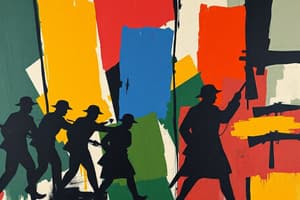Podcast
Questions and Answers
Which Canadian Prime Minister played a key role in the formation of NATO?
Which Canadian Prime Minister played a key role in the formation of NATO?
- Lester B Pearson (correct)
- John Diefenbaker
- Robert Borden
- Pierre Trudeau
During which battle did the Canadian Expeditionary Force suffer heavy losses in World War I?
During which battle did the Canadian Expeditionary Force suffer heavy losses in World War I?
- Battle of Ypres (correct)
- Dunkirk
- Dieppe
- Battle of Somme (correct)
Which of the following cultural movements was popularized in the 1920s?
Which of the following cultural movements was popularized in the 1920s?
- Flappers (correct)
- Hippies
- Punks
- Hipsters
Which Canadian Prime Minister was a strong supporter of the British Empire during World War I?
Which Canadian Prime Minister was a strong supporter of the British Empire during World War I?
What was the name of the Canadian political party that advocated for social credit economics?
What was the name of the Canadian political party that advocated for social credit economics?
What was the primary intention of the Allied evacuation at Dunkirk?
What was the primary intention of the Allied evacuation at Dunkirk?
Which of the following events is often seen as a precursor to the larger Allied invasion of Nazi-occupied France?
Which of the following events is often seen as a precursor to the larger Allied invasion of Nazi-occupied France?
What was the main purpose of the NATO alliance formed in 1949?
What was the main purpose of the NATO alliance formed in 1949?
What was the primary cause of the failure of the Dieppe Raid?
What was the primary cause of the failure of the Dieppe Raid?
What was the historical context in which the Prohibition movement emerged in Canada?
What was the historical context in which the Prohibition movement emerged in Canada?
Flashcards are hidden until you start studying
Study Notes
Canadian History and Politics
- The Social Credit Party was a Canadian political party founded in 1935, known for its social credit economic theory and populist policies.
- Lester B. Pearson was the 14th Prime Minister of Canada, serving from 1963 to 1968, and was awarded the Nobel Peace Prize in 1957.
- John Diefenbaker was the 13th Prime Minister of Canada, serving from 1957 to 1963, and was a strong advocate for Canadian autonomy and national unity.
- Robert Borden was the 8th Prime Minister of Canada, serving from 1911 to 1920, and led the country during World War I.
World War I
- The Battle of Ypres was a series of battles fought in 1915 during World War I, resulting in heavy casualties and the first use of poison gas by Germany.
- The Battle of Somme was a pivotal battle fought in 1916 during World War I, resulting in over one million casualties and minimal territorial gains.
World War II
- The Battle of Dunkirk was a military evacuation of Allied soldiers during World War II, taking place from May to June 1940, with over 338,000 troops rescued.
- The Dieppe Raid was a failed Allied attack on the German-occupied French port of Dieppe during World War II, resulting in heavy casualties and a significant loss of life.
Cultural and Social Movements
- Flappers were a symbol of the liberated woman during the Roaring Twenties, characterized by their short skirts, bobbed hair, and rejection of traditional social norms.
International Relations
- NATO (North Atlantic Treaty Organization) is a military alliance established in 1949, providing collective defense against potential security threats.
Canadian History and Politics
- The Social Credit Party was a political party in Canada that had a significant influence on the country's governance.
- Lester B. Pearson was a prominent Canadian politician who played a crucial role in shaping the country's foreign policy and was awarded the Nobel Peace Prize.
- John Diefenbaker was the 13th Prime Minister of Canada, serving from 1957 to 1963, and was known for his progressive policies.
- Robert Borden was the 8th Prime Minister of Canada, serving from 1911 to 1920, and played a key role in leading the country during World War I.
World War I
- The Battle of Ypres was a series of battles fought during World War I, which took place in the Ypres Salient in West Flanders, Belgium.
- The Battle of Somme was one of the bloodiest battles of World War I, fought between July and November 1916, resulting in heavy casualties on both sides.
World War II
- Dunkirk was a major military operation during World War II, where hundreds of thousands of Allied soldiers were evacuated from the beaches of Dunkirk, France.
- Dieppe was a failed Allied assault on the German-occupied French port of Dieppe, which resulted in heavy casualties and was one of the bloodiest battles of World War II.
Social and Cultural Trends
- Flappers were a subculture of young women in the 1920s who rejected traditional social norms and emerged as a symbol of modernity and freedom.
International Relations
- NATO (North Atlantic Treaty Organization) is a military alliance established in 1949, comprising North American and European countries, aimed at providing collective defense against potential security threats.
Studying That Suits You
Use AI to generate personalized quizzes and flashcards to suit your learning preferences.




